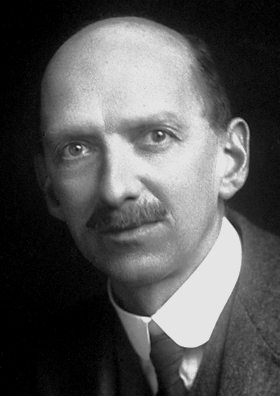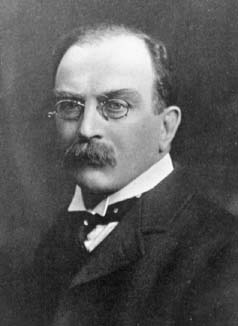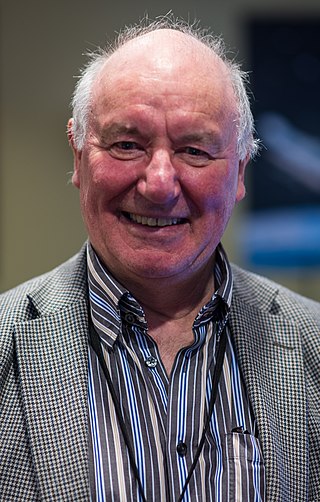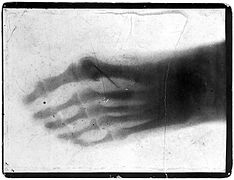
The Cavendish Laboratory is the Department of Physics at the University of Cambridge, and is part of the School of Physical Sciences. The laboratory was opened in 1874 on the New Museums Site as a laboratory for experimental physics and is named after the British chemist and physicist Henry Cavendish. The laboratory has had a huge influence on research in the disciplines of physics and biology.

Charles Thomson Rees Wilson was a Scottish physicist and meteorologist who shared the 1927 Nobel Prize in Physics with Arthur Compton for his invention of the cloud chamber.

Sir Joseph Larmor was an Irish physicist and mathematician who made breakthroughs in the understanding of electricity, dynamics, thermodynamics, and the electron theory of matter. His most influential work was Aether and Matter, a theoretical physics book published in 1900.

Arthur Holmes was an English geologist who made two major contributions to the understanding of geology. He pioneered the use of radiometric dating of minerals, and was the first earth scientist to grasp the mechanical and thermal implications of mantle convection, which led eventually to the acceptance of plate tectonics.

George Udny Yule, CBE, FRS, usually known as Udny Yule, was a British statistician, particularly known for the Yule distribution and proposing the preferential attachment model for random graphs.

Malcolm Sim Longair is a British physicist. From 1991 to 2008 he was the Jacksonian Professor of Natural Philosophy in the Cavendish Laboratory at the University of Cambridge. Since 2016 he has been Editor-in-Chief of the Biographical Memoirs of Fellows of the Royal Society.

Fellowship of the Royal Society of Edinburgh (FRSE) is an award granted to individuals that the Royal Society of Edinburgh, Scotland's national academy of science and letters, judged to be "eminently distinguished in their subject". This society received a royal charter in 1783, allowing for its expansion.

Cargill Gilston Knott FRS, FRSE LLD was a Scottish physicist and mathematician who was a pioneer in seismological research. He spent his early career in Japan. He later became a Fellow of the Royal Society, Secretary of the Royal Society of Edinburgh, and President of the Scottish Meteorological Society.

Alexander Smith was a Scottish chemist, who spent his working life teaching in the universities of America.
Edmund Clifton Stoner FRS was a British theoretical physicist. He is principally known for his work on the origin and nature of itinerant ferromagnetism, including the collective electron theory of ferromagnetism and the Stoner criterion for ferromagnetism. Stoner made significant contributions to the electron configurations in the periodic table.

Nicholas Kemmer was a Russian-born nuclear physicist working in Britain, who played an integral and leading edge role in United Kingdom's nuclear programme, and was known as a mentor of Abdus Salam – a Nobel laureate in physics.
Norman Feather FRS FRSE PRSE, was an English nuclear physicist. Feather and Egon Bretscher were working at the Cavendish Laboratory, Cambridge in 1940, when they proposed that the 239 isotope of element 94 (plutonium) would be better able to sustain a nuclear chain reaction. This research, a breakthrough, was part of the Tube Alloys project, the secret British project during World War II to develop nuclear weapons.
Dirk ter Haar FRSE FIP DSc was an Anglo-Dutch physicist.
Prof Hyman Levy was a Scottish-Jewish philosopher, Emeritus Professor of Imperial College London, mathematician, political activist and fellow of the Royal Society of Edinburgh.
Arthur James Cochran Wilson, FRS was a Canadian-British crystallographer known for his work on the statistical aspects of X-ray crystallography.

Madge Gertrude Adam was an English solar astronomer who was the first postgraduate student in solar physics at the University of Oxford observatory.
Ian Naismith Sneddon was a Scottish mathematician who worked on analysis and applied mathematics.
Alan James Duncan FRSE FRSA was a Scottish atomic physicist who created a metastable atomic hydrogen beam apparatus used to first observe the two-photon decay of metastable hydrogen and measure fundamental predictions of quantum theory.

William Jack FRSE was a Scottish mathematician and journalist. He was Editor of the Glasgow Herald newspaper from 1870 to 1876, and Professor of Mathematics at the University of Glasgow from 1879 until 1909.

Ronald Gordon Giovanelli, DSc, FAA was an Australian solar researcher, astronomer and physicist, who contributed to the fields of astrophysics, solar physics, radiative transfer, and astronomical optics. His career spanned more than 40 years, commencing prior to World War II. Giovanelli was the recipient of the 1949 Edgeworth David Medal by the Royal Society of New South Wales for the discipline of astrophysics, which recognises distinguished contributions by scientists under the age of 35 in their respective fields. He was also elected into the Fellowship of the Australian Academy of Science in 1962 for his contributions in the field of physics.


















